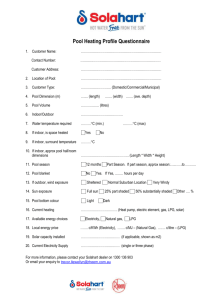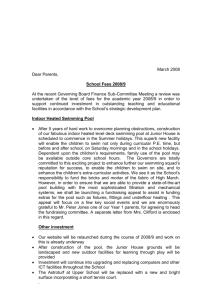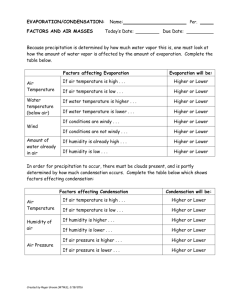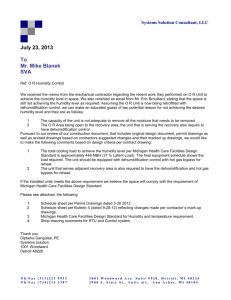July 6, 2005 - Energy Ideas Clearinghouse
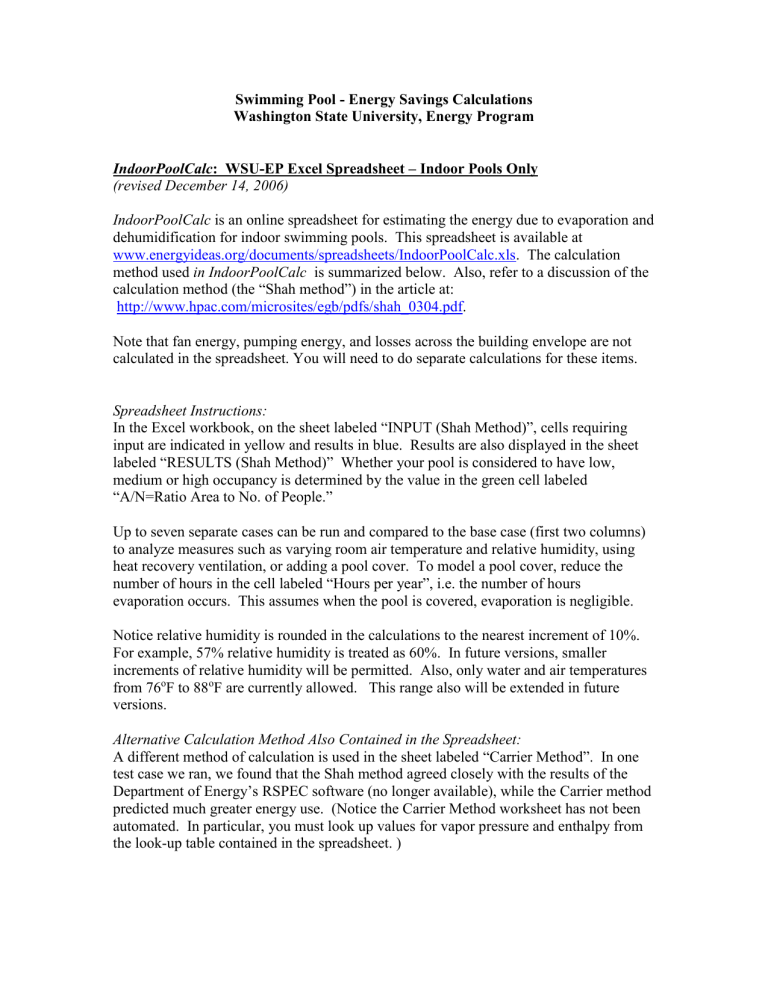
Swimming Pool - Energy Savings Calculations
Washington State University, Energy Program
IndoorPoolCalc: WSU-EP Excel Spreadsheet – Indoor Pools Only
(revised December 14, 2006)
IndoorPoolCalc is an online spreadsheet for estimating the energy due to evaporation and dehumidification for indoor swimming pools. This spreadsheet is available at www.energyideas.org/documents/spreadsheets/IndoorPoolCalc.xls
. The calculation method used in IndoorPoolCalc is summarized below. Also, refer to a discussion of the calculation method (the “Shah method”) in the article at: http://www.hpac.com/microsites/egb/pdfs/shah_0304.pdf
.
Note that fan energy, pumping energy, and losses across the building envelope are not calculated in the spreadsheet. You will need to do separate calculations for these items.
Spreadsheet Instructions:
In the Excel workbook, on the sheet labeled “INPUT (Shah Method)”, cells requiring input are indicated in yellow and results in blue. Results are also displayed in the sheet labeled “RESULTS (Shah Method)” Whether your pool is considered to have low, medium or high occupancy is determined by the value in the green cell labeled
“A/N=Ratio Area to No. of People.”
Up to seven separate cases can be run and compared to the base case (first two columns) to analyze measures such as varying room air temperature and relative humidity, using heat recovery ventilation, or adding a pool cover. To model a pool cover, reduce the number of hours in the cell labeled “Hours per year”, i.e. the number of hours evaporation occurs. This assumes when the pool is covered, evaporation is negligible.
Notice relative humidity is rounded in the calculations to the nearest increment of 10%.
For example, 57% relative humidity is treated as 60%. In future versions, smaller increments of relative humidity will be permitted. Also, only water and air temperatures from 76 o
F to 88 o
F are currently allowed. This range also will be extended in future versions.
Alternative Calculation Method Also Contained in the Spreadsheet:
A different method of calculation is used in the sheet labeled “Carrier Method”. In one test case we ran, we found that the Shah method agreed closely with the results of the
Department of Energy’s RSPEC software (no longer available), while the Carrier method predicted much greater energy use. (Notice the Carrier Method worksheet has not been automated. In particular, you must look up values for vapor pressure and enthalpy from the look-up table contained in the spreadsheet. )
RETScreen International Model – Indoor & Outdoor Pools
RETScreen International has developed a user-friendly, spreadsheet-based application
“SWH3” for sizing solar water heating systems for indoor and outdoor swimming pools.
One of the results of this model is the “energy demand” in MWh. RETScreen has inputs for the hours per day a pool cover is used and the fraction of each month the pool is heated. While their model assumes solar energy will provide part of this energy, this result can be adjusted to reflect a different system providing the energy. For example, if a boiler is used divide this result by the boiler’s efficiency. For a heat pump, divide by the average COP.
You may download the RETSceen “Solar Water Heater” model and the e-Textbook from their website at http://www.retscreen.net/ang/t.php
. Also, available at this site is an
“Engineering e-Textbook” that outlines their calculation method.
For outdoor swimming pools, the model has weather data for sites all over the world. For an indoor swimming pool, RETScreen assumes the following indoor conditions, which cannot be adjusted:
Indoor dry bulb temperature = the greater of 81 o
F or the outdoor temperature
Indoor relative humidity = 60%,
Ventilation rate = 6 to 8 air changes per hour.
If your indoor conditions are different from these, the WSU-EP spreadsheet discussed below may be the better choice for modeling indoor swimming pools.
RETScreen Instructions for Swimming Pools :
After installing and opening the model, go to the sheet “Solar Resource & Heating Load”.
Select your site by clicking on “See Weather Database” link to the right. In the next section, enter the fraction of each month the pool is heated in the yellow cells. Scroll down to the bottom section to select whether this is an indoor or outdoor pool, the size of the pool, water temperature, etc. The result is the “energy demand for months analyzed” at the bottom of this sheet. This result does not include energy for pumping, dehumidification, fans, etc. This is strictly heating energy requirements.
Notice that “renewable energy delivered” on the sheet “Energy Model” often gives a lower energy delivered than the energy demand. This indicates that the solar system is not sufficient to provide 100% of the heating energy requirements. For your needs, stick with the “energy demand” on the “Solar Resource & Heating Load” sheet.
IndoorPoolCalc: Calculation Background
Energy savings from an indoor swimming pool are primarily due to reduced evaporation from the surface of the pool and reduced dehumidification. HVAC savings due to reduced indoor air temperature in the winter and increased air temperature in the summer have not been calculated here, but should be considered when adjusting the indoor air temperature.
The U.S. Department of Energy (DOE) reports that evaporation typically accounts for
70% of the energy use of an indoor pool. Another 27% of energy use is due to ventilation required to control humidity in the building. All other losses typically account for only 3% of the total. If humidity levels are controlled using a heat pump dehumidifier with latent heat recovery moisture from the air can be efficiently removed and returned to the space. With such a system, much of the latent heat of evaporation is recovered at the heat pump’s condensing coils and used to preheat pool water. Outside air is required to maintain indoor air quality, but not to control relative humidity. Therefore, with heat pump dehumidification with heat recovery, the losses due to ventilation also will be less than is typical and energy loss due to evaporation and other losses will be a correspondingly larger fraction of the total. Note that ventilation (and dehumidication too) increases the water heating required because of the lower humidity, but ventilation reduces the dehumidification required.
The evaporation rate E is calculated using the Shah method described in “Calculating
Evaporation from Indoor Water Pools” (Shah, 2004). The Shah correlation for calculating E o
(lbm w
/hr) from unoccupied pools is
E o
K
A
w
r
w
1 /
W w
W r
(Eq. 5) where A is the surface area of the pool, ρ w
and W w
are the density and humidity ratio, respectively, of air at the water surface, ρ r
and W r
are the density and humidity ratio, respectively, of air at room conditions. K is a constant determined by the difference in density. For area in square feet, density in lbm/ft
3
and humidity ratio in lbm w
/lbm a
, K is
K
290 if
K
333 if
r
w
0 .
00125
r
w
0 .
00125
(Eq. 6)
This unoccupied evaporation is adjusted to account for the significant affect of swimmers on evaporation losses:
E
E o
160
N
A
1
E
E o
62 .
9
N
A
1 .
2 if if
N
A
500 sq .
ft occ
50
N
A
500 sq .
ft occ
E
2 .
5 E o if
N
A
50 sq .
ft occ where A is the surface area of the pool and N is the number of swimmers.
(Eq. 7)
Note that the Carrier method, outlined in ASHRAE Applications (2003), predicts much greater rates of evaporation and best describes evaporation at high occupancies. In experimental measurements performed by Shah, he confirmed that the Carrier method significantly overpredicted evaporation for low occupancies. We calculated the energy use of a U.S. naval station pool for which results of the DOE’s software RSPEC were available, using both the Shah method and the Carrier method. Results of the Shah method agreed very closely with RSPEC results, while the Carrier method predicted 67% greater energy use.
Except for that dehumidification accomplished through introduction of outside air and not considering the COP of the dehumidifier, the energy required for dehumidification approximately equals the heat loss due to evaporation. Latent heat of evaporation may be largely recovered using heat pump for dehumidification. One manufacturer of heat pump dehumidifiers, PoolPak, reports that 70% to 80% of latent heat loss can be recovered with their equipment. Therefore, there will be an additional heat loss due to, for example, infiltration.
The energy required for heating q
HTG
is estimated as: q
HTG
E
n
h
L
1
f
R
1
B f
E
f
E
(Eq. 8) where E is the evaporation rate in lbm per hour calculated by the Shah method, n is the number of hours per year the pool is uncovered, h
L
is the latent heat of evaporation in Btu per lbm, f
R
is the fraction of heat recovered by the heat pump dehumidifier, f
E
is the fraction of heat that is lost due to infiltration or other losses, and
η
B
is the efficiency of the boiler or the COP of a heat pump water heater (which may also serve as the heat pump dehumidifier.)
The energy required for dehumidification is estimated as q
DEH
E
n
h
L
1
f
E
(Eq. 9)
COP where COP is the average coefficient of performance of the dehumidifier, which may be assumed to be 1.0 for all dehumidifier types except heat pumps.
Note that accounting for ventilation by assuming a fraction of the heat lost f
E
is very simplified. A more accurate method would require using outdoor temperature and humidity data from typical weather data and would significantly increase the complexity of the calculation. We did not feel the more accurate calculation would be worth the effort since heat loss due to ventilation is minor compared to that due to evaporation.
Comments on the spreadsheet and calculation method are welcomed. Please send them to Carolyn Roos at roosc@energy.wsu.edu
.
References
ASHRAE Handbook, HVAC Applications , American Society of Heating, Refrigerating and Air-Conditioning Engineers, Atlanta, GA, 2003
Shah, Mohammed M., HPAC Engineering , “Calculating Evaporation from Indoor Water
Pools,” March 2004
U.S. Department of Energy, Energy Efficiency and Renewable Energy, “Indoor
Swimming Pools”, factsheet available at http://www.eere.energy.gov/consumerinfo/factsheets/indoor_pools.html
